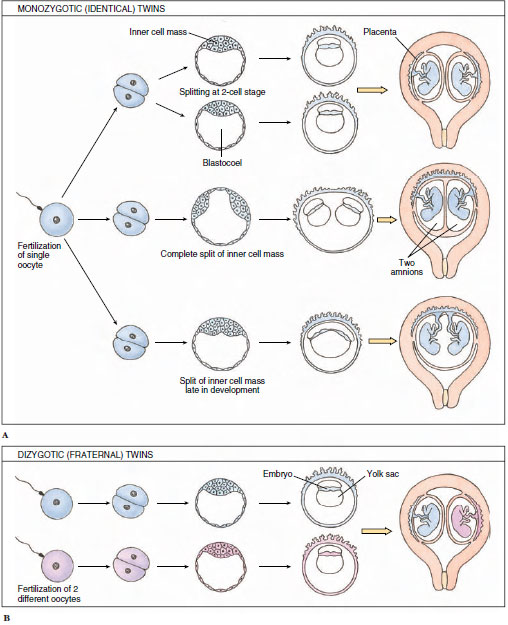Multiple Births
Multiple Births
Many mammals give birth to more than one offspring at a time or to a litter (multiparous), each member of which has come from a separate egg. There are some mammals, however, that have only one offspring at a time (uniparous), although occasionally they may have more than one young. The armadillo (Dasypus) is almost unique among mammals in giving birth to four young at one time—all of the same sex, either male or female, and all derived from the same zygote.
Human twins may come from one zygote (identical, or monozygotic twins; Figure 7-19A) or two zygotes (nonidentical, dizygotic, or fraternal twins; Figure 7-19B). Fraternal twins do not resemble each other any more than other children born separately in the same family, but identical twins are, of course, strikingly alike and always of the same sex. Triplets, quadruplets, and quintuplets may include a pair of identical twins. The other babies in such multiple births usually come from separate zygotes. About 33% of identical twins have separate placentas, indicating that the blastomeres separated at an early, possibly the two-cell, stage (Figure 7-19A, top). All other identical twins share a common placenta, indicating that splitting occurred after formation of the inner cell mass (see Figure 8-23). If splitting were to happen after placenta formation, but before the amnion forms, the twins would have individual amniotic sacs (Figure 7-19A, middle), as observed in the great majority of identical twins. Finally, a very small percentage of identical twins share one amniotic sac and a single placenta (Figure 7-19A, bottom), indicating that separation occurred after day 9 of pregnancy, by which time the amnion has formed. In these cases, the twins are at risk of becoming conjoined, a condition known as Siamese twinning. Embryologically, each member of fraternal twins has its own placenta and amnion (Figure 7-19B).
The frequency of twin births in comparison to single births is approximately 1 in 86, that of triplets 1 in 862, and that of quadruplets approximately 1 in 863. Frequency of identical twin births to all births is about the same the world over, whereas frequency of fraternal births varies with race and country. In the United States, threefourths of all twin births are dizygotic (fraternal), whereas in Japan only a little more than one-fourth are dizygotic.The tendency for fraternal twinning (but apparently not identical twinning) seems to run in family lines; fraternal twinning (but not identical twinning) also increases in frequency as mothers get older.
Many mammals give birth to more than one offspring at a time or to a litter (multiparous), each member of which has come from a separate egg. There are some mammals, however, that have only one offspring at a time (uniparous), although occasionally they may have more than one young. The armadillo (Dasypus) is almost unique among mammals in giving birth to four young at one time—all of the same sex, either male or female, and all derived from the same zygote.
Human twins may come from one zygote (identical, or monozygotic twins; Figure 7-19A) or two zygotes (nonidentical, dizygotic, or fraternal twins; Figure 7-19B). Fraternal twins do not resemble each other any more than other children born separately in the same family, but identical twins are, of course, strikingly alike and always of the same sex. Triplets, quadruplets, and quintuplets may include a pair of identical twins. The other babies in such multiple births usually come from separate zygotes. About 33% of identical twins have separate placentas, indicating that the blastomeres separated at an early, possibly the two-cell, stage (Figure 7-19A, top). All other identical twins share a common placenta, indicating that splitting occurred after formation of the inner cell mass (see Figure 8-23). If splitting were to happen after placenta formation, but before the amnion forms, the twins would have individual amniotic sacs (Figure 7-19A, middle), as observed in the great majority of identical twins. Finally, a very small percentage of identical twins share one amniotic sac and a single placenta (Figure 7-19A, bottom), indicating that separation occurred after day 9 of pregnancy, by which time the amnion has formed. In these cases, the twins are at risk of becoming conjoined, a condition known as Siamese twinning. Embryologically, each member of fraternal twins has its own placenta and amnion (Figure 7-19B).
The frequency of twin births in comparison to single births is approximately 1 in 86, that of triplets 1 in 862, and that of quadruplets approximately 1 in 863. Frequency of identical twin births to all births is about the same the world over, whereas frequency of fraternal births varies with race and country. In the United States, threefourths of all twin births are dizygotic (fraternal), whereas in Japan only a little more than one-fourth are dizygotic.The tendency for fraternal twinning (but apparently not identical twinning) seems to run in family lines; fraternal twinning (but not identical twinning) also increases in frequency as mothers get older.
 |
| Figure 7-19 Formation of human twins. A, Monozygotic (identical) twin formation. B, Dizygotic (fraternal) twin formation. See text for explanation |




